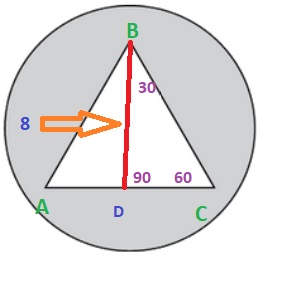Carcass wrote:
Attachment:
The attachment #greprepclub In the figure above, the height of the equilateral triangle is 8 and the radius of the circle is 7. .jpg is no longer available
In the figure above, the height of the equilateral triangle is 8 and the radius of the circle is 7.
Quantity A |
Quantity B |
The area of the shaded region |
105 |
A)The quantity in Column A is greater.
B)The quantity in Column B is greater.
C)The two quantities are equal.
D)The relationship cannot be determined from the information given.
Kudos for the right answer and explanation[/m]
Attachment:
 #greprepclub In the figure above, the height of the equilateral triangle is 8 and the radius of the circle is 7. .jpg [ 15.53 KiB | Viewed 3690 times ]
#greprepclub In the figure above, the height of the equilateral triangle is 8 and the radius of the circle is 7. .jpg [ 15.53 KiB | Viewed 3690 times ]
Here,
Let refer to the diagram
ABC is equilateral \(\triangle\)
AD is the height of the \(\triangle\) = 8
For the \(\triangle\) ADC
\(\angle CAD = 30\)
\(\angle ADC = 90\)
\(\angle DCA = 60\)
It is a 30 -60-90 \(\triangle \) and the sides are distributed in the ratio \(1\) : \(\sqrt{3}\) : \(2\)
since, the height AD = 8, hence the sides are distributed as
\(\frac{8}{(\sqrt{3})}\) : \(8\) : \(\frac{16}{(\sqrt{3})}\)
i.e one side of the equilateral \(\triangle\) = \(\frac{16}{(\sqrt{3})}\)
Area of equilateral \(\triangle\) = \(\frac{(\sqrt 3 * {side}^2)}{4}\) =\(\frac{\sqrt 3 * ({\frac {16}{\sqrt3}})^2}{4}\) = 37 (approx)
Now,
Area of the circle of radius '7' = \(\pi * {radius}^2 \) = \(\pi *49\) = 154
Therefore, Area of the shaded region = 154 - 37 = 117QTY A > QTY B








 70% (02:13) correct
70% (02:13) correct





